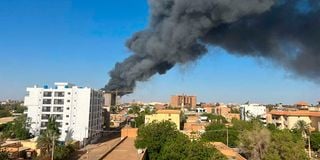Premium
When it rains in Africa…

A column of smoke rises behind buildings near the airport area in Khartoum on April 19, 2023, amid fighting between the army and paramilitaries following the collapse of a 24-hour truce.
Life in Sudan’s capital, Khartoum, was turned upside-down as military ruler Gen Abdel Fattah al-Burhan, commander-in-chief of the Sudanese Armed Forces (SAF), and his erstwhile ally, Gen Mohamed Hamdan Dagalo “Hemedti”, the head of the powerful paramilitary Rapid Support Forces (RSF), went to war. The city has seen unrelenting fighting and bombardment since.
As of Tuesday, 200 civilians were reported killed and 2,000 injured in the fighting.
Burhan and Hemedti go way back. They oversaw the deadly war in Darfur, Burhan as military chief and Hemedti leader of the murdering Janjaweed pro-government militia.
In October 2021, they carried out a coup against the interim civilian administration of Prime Minister Abdalla Hamdok. Hemedti had set up the RSF as a respectable replacement for Janjaweed.
The outbreak of the fighting in Khartoum brought a wave of Afropessimism. When one thinks it can’t get worse in Africa, it does. With the bloody war in Ethiopia’s Tigray ending, the region desperately needed a break. It didn’t get it.
So, yes, Africa is being Africa, but it has and will survive. It survives because, while the centre often falls apart, the margins are stable, creative and hold together. Many a time, the events on the margins don’t involve the state; occasionally, they do.
Let’s look at the past few weeks, starting with Kenya. A group called 14Trees is building the world’s largest 3D-printed affordable housing development in Kilifi. Not only that, it reportedly got the first 10 houses printed in just as many weeks.
14Trees is 3D-printing 52 affordable houses in Kilifi town. When completed, the development, which is called Mvule (African teak) Gardens, will be the largest 3D-printed affordable housing complex.
Kenya and Tanzania are also doing something radical—with rats. Recently, it was reported that Tanzanian and Kenyan scientists with the APOPO Project, which has been in the news in recent years for training rats to smell landmines—with the rodents deployed in places like Mozambique and Vietnam—have trained them to sniff out tuberculosis (TB) and they’re proving more sensitive than microscope testing.
The rats were also able to detect characteristics of TB independent of a person’s HIV status, which disrupts existing TB testing. TB still kills millions worldwide and, in the Tanzanian commercial capital Dar es Salaam, the APOPO rats have replaced normal testing in 21 health clinics, according to an Africa News report.
Conventional techniques
Conventional laboratory techniques can take anywhere from two hours to 14 days for a sample. The rats can complete the testing of 50 samples in two hours, which would be ideal in distant or remote places.
Enter Paul Waweru, a Kenyan high school teacher who reportedly uses old laptop batteries to ‘electrify’ petrol-powered bikes.
Waweru turns second-hand electronics destined to become waste products into something useful. He cannibalises the laps for the cells that still can hold a decent charge. He then configures them into battery packs to replace the internal combustion engines of scooters and bikes.
“Nobody was selling electric bikes in Kenya, so I had to import one,” he told African News. The imported bicycle didn’t last long, so he used his innovation to create a more durable alternative. The company that he founded, Ecomobilus, is doing well.
On the sharper innovation edge, we were delighted to read that Africa recently achieved its first domestic cancer test with the arrival of a Moroccan-born test for breast cancer and leukaemia.
Most diagnostics kits are imported from Europe or North America. The test, developed by the Moroccan Foundation for Advanced Science, Innovation and Research (MASciR), could hugely reduce cost and wait times.
MASciR was one of the first firms in Africa to develop a Covid-19 test, which was sold in Tunisia, Senegal and Cote d’Ivoire, as well as Rwanda. The cancer tests will likely be available in these countries first.
Staying with health things, Ghana has become the first country to approve a new malaria vaccine. The R21 vaccine, from Oxford University, will be given to children aged five months to three years.
R21 has already been given to 4,000 infants in six African countries. Described as a “world-changer” by the scientists who developed it, R21 was up to 80 per cent efficacious when given in three doses and followed up with a booster a year later in a preliminary trial in Burkina Faso.
That final trial data drew on a study of almost 5,000 children in Burkina Faso, Kenya, Mali and Tanzania. The Serum Institute of India is preparing to produce 100-200 million doses per year and a vaccine factory is being built in Ghana’s capital, Accra.
There was also some good in politics, Africa’s leading producer of gloom. Gabon’s parliament voted to reduce a presidential term from seven to five years as part of a constitutional amendment, thank you.
Mr Onyango-Obbo is a journalist, writer and curator of the “Wall of Great Africans”. @cobbo3





